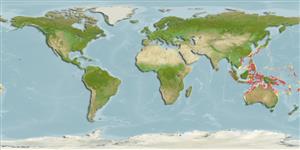Classification / Names
Common names | Synonyms | Catalog of Fishes (gen., sp.) | ITIS | CoL | WoRMS | Cloffa
Actinopterygii (ray-finned fishes) >
Syngnathiformes (Pipefishes and seahorses) >
Syngnathidae (Pipefishes and seahorses) > Hippocampinae
Etymology: Hippocampus: Greek, ippos = horse + Greek,kampe = curvature (Ref. 45335); pontohi: Named for Hence Pontoh, the Indonesian dive guide who first brought these pygmy seahorses to our attention.
Environment / Climate / Range
Ecology
Marine; benthopelagic; non-migratory; depth range 8 - 25 m (Ref. 79848). Tropical, preferred ?
South East Asia: Indonesia (Ref. 79848) and Papua New Guinea (Ref. 90102).
Size / Weight / Age
Maturity: Lm ? range ? - ? cm
Max length : 1.7 cm SL male/unsexed; (Ref. 79848); 1.6 cm SL (female)
Short description
Morphology | Morphometrics
Dorsal
soft rays
(total): 14. Extremely small size (height 14 mm, standard length 17 mm); 12 trunk rings; 26–28 tail rings; reduced ossification of inferior and ventral trunk ridges; small or absent anal fin; brooding area in males anterior to anus; medium length snout which lacks a bulbous tip; raised, angular coronet; fused (or almost fused in holotype) gill-openings on midline behind coronet supported by raised cleithral girdle; scattered tubercles on trunk and tail; distinctive branching filaments (usually red in life) attached to the enlarged superior trunk ridge spine of the fifth trunk ring; white colour, occasionally with yellow or pink especially along the dorsal surface, with fine red lines on the trunk, and reddish transverse bands across the tail (Ref. 79848).
Hippocampus pontohi has been observed on the coralline algae Halimeda, as well as on the hydroid Aglaephenia cupressina (Müller and Severns, pers. comm.). Severns noted it particularly in areas where Halimeda is growing on reef walls. It has been recorded at a number of areas in Indonesia (Bunaken, Cape Sri, Sorong, Wakatobi, Lembeh Straits), at depths of between 11-25 m particularly on vertical walls or in rock fissures on current-swept walls where it will tend to occur on the side of the fissure that faces away from the current, but in all cases where there is some upward current (Müller, pers. comm.) and has been seen swimming over a fungiid coral (Hardt, pers. comm.). Hippocampus pontohi is commonly found in pairs and, like H. denise, is relatively active in the morning and late afternoon when it is not in direct sunlight (Müller, pers. comm.). Two of the specimens examined were pregnant and each contained approximately 11 embryos (Ref. 79848).
Life cycle and mating behavior
Maturity | Reproduction | Spawning | Eggs | Fecundity | Larvae
Male carries the eggs in a brood pouch (Ref. 205).
Lourie, S.A. and R.H. Kuiter, 2008. Three new pygmy seahorse species from Indonesia (Teleostei: Syngnathidae: Hippocampus). Zootaxa 1963:54-68. (Ref. 79848)
IUCN Red List Status (Ref. 115185)
Threat to humans
Harmless
Human uses
More information
Age/SizeGrowthLength-weightLength-lengthLength-frequenciesMorphometricsMorphologyLarvaeLarval dynamicsRecruitmentAbundance
ReferencesAquacultureAquaculture profileStrainsGeneticsAllele frequenciesHeritabilityDiseasesProcessingMass conversion
Tools
Special reports
Download XML
Internet sources
Estimates of some properties based on models
Phylogenetic diversity index (Ref.
82805): PD
50 = 0.5000 [Uniqueness, from 0.5 = low to 2.0 = high].
Bayesian length-weight: a=0.00427 (0.00168 - 0.01086), b=3.00 (2.78 - 3.22), in cm Total Length, based on LWR estimates for this (Sub)family-body shape (Ref.
93245).
Trophic Level (Ref.
69278): 3.0 ±0.5 se; Based on size and trophs of closest relatives
Resilience (Ref.
69278): High, minimum population doubling time less than 15 months (Preliminary K or Fecundity.).
Vulnerability (Ref.
59153): Low vulnerability (10 of 100) .
